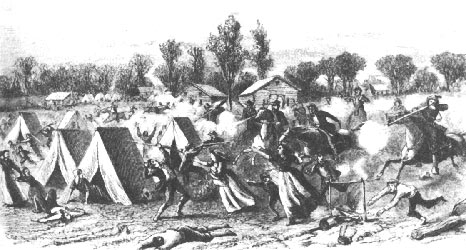
Last week historian Andrea Radke-Moss made headlines with the revelation that Missouri ruffians raped Eliza R. Snow during the 1838 Mormon War. Snow was a beloved “founding mother” of Mormonism and went on to become one of the longest-serving Relief Society presidents.
Evidence of the rape comes from an autobiography of Alice Merrill Horne, granddaughter of one of Snow’s closest friends. Horne’s words suggest how social norms of female sexual purity may increase the trauma of an already traumatic experience:
There was a saint—a Prophetess, a Poet, an intellectual, seized by brutal mobbers—used by those eight demons and left not dead, but worse. The horror, the anguish, despair, hopelessness of the innocent victim was dwelt upon. What future was there for such a one? For her, no home life could open! All aspirations of a saintly virgin—that maiden of purity—had met martyrdom!*
Horne went on to praise Joseph Smith for showing compassion to Snow by accepting her as one of his plural wives. One might instead wonder whether Snow settled for becoming a fourteenth wife because she believed herself damaged and he offered her redemption. Feelings of guilt and worthlessness may victimize women long after an assault occurs.
Victims of rape often suffer in silence. 68% of rapes today go unreported, and nineteenth-century women were even more reluctant to talk about sexual assault. Mormon War documents referred to several rapes, but rarely named the victims or offenders. Historians are left to read between the lines to identify the victims.
For instance, historian Joseph Johnstun has identified Hannah Kinney Johnstun as another victim of Missouri rapists. Three months after the sack of Far West, her February 1839 patriarchal blessing reassured her that “thy character stands fair, no sin is chargeable against thee . . . thy virtue is unsullied, thy name stands pure.” That summer she gave birth to a baby girl.
In my own research on Missouri I’ve collected several accounts of sexual assault, including one that Radke-Moss may not have noticed. This account comes from an 1890 reminiscence of Ebenezer Robinson, formerly of the Far West High Council.
After the Mormon surrender in November 1838, some 40 male church leaders were imprisoned in the Richmond Courthouse. No women were imprisoned with them. Here Ebenezer Robinson “saw one of the guard perpetrate upon one of the prisoners an indignity too indecent to be named.”
This appears to describe some kind of sexual assault upon a male Church leader by one of the jailers tasked to guard him, though Robinson is unspecific. His words could refer to anything from urination on a prisoner to penetration with a body part or object.
Men don’t face the risks of pregnancy and infertility from sexual assault that women do, but there can still be considerable physical trauma associated with male sexual assault as well as social and emotional consequences.
Male victims report sexual assault even less often than women, though for somewhat different reasons. Male shame stems from loss of power more than loss of purity, and men also feel pressure to be “strong” in the face of trauma. Gender norms designed to enforce their male privilege may trap and silence male victims just as effectively as the norms for women. And because they don’t speak out, policymakers tend to overlook them.
The rape of a jailed male Mormon leader should perhaps occasion some reflection in an election season when criminal justice reform is a major campaign issue. Male-on-male sexual assault remains a huge problem in a chronically overpopulated American prison system that systematically discriminates against minorities. White Mormons today stand firmly in the ruling class, but their founding mothers and fathers experienced firsthand what it means to be a minority.
* Credit to Joseph Johnstun for passing this text along to me, Lavina Fielding Anderson for passing it to Joseph, and Joe Jeppsen for originally finding it many years ago. Thanks also to Andrea Radke-Moss for permission to post it and for bringing this source to light.